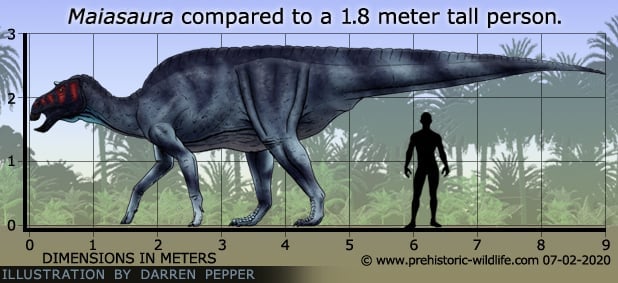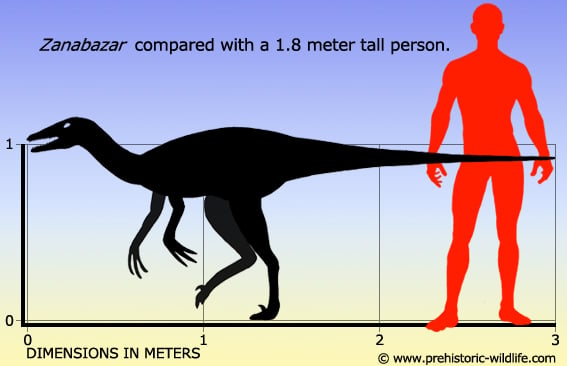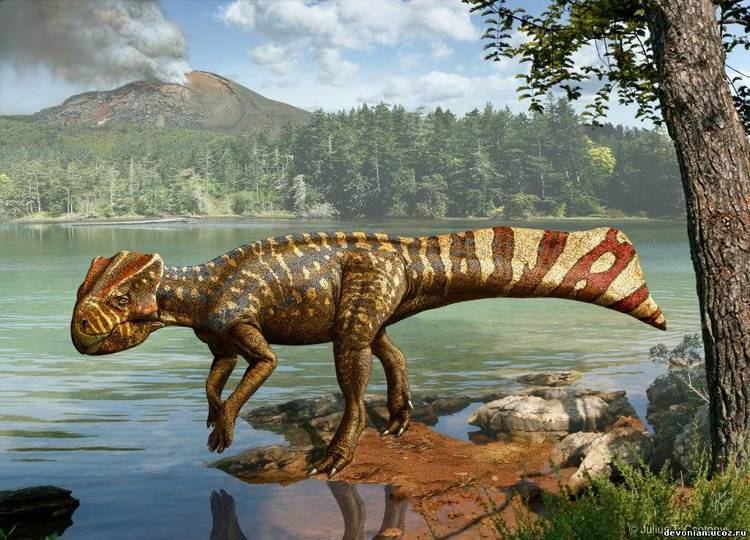Tix Mascot
Tech guru
Italy is my second homeland
Posts: 11,076  Mini-Profile Background: {"image":"http://4.bp.blogspot.com/-X5mhw13BJ7Y/TwKeZ3uM7YI/AAAAAAAABPw/D82go4Ny_8E/s1600/italy-background-8-787281.jpg","color":""}
Mini-Profile Text Color: 0ef8f1
Mini-Profile Name Color: f40d39
Year of Birth: 1961
Nationality: Norwegian
Mini-Profile Background: {"image":"http://4.bp.blogspot.com/-X5mhw13BJ7Y/TwKeZ3uM7YI/AAAAAAAABPw/D82go4Ny_8E/s1600/italy-background-8-787281.jpg","color":""}
Mini-Profile Text Color: 0ef8f1
Mini-Profile Name Color: f40d39
Year of Birth: 1961
Nationality: Norwegian
|
Post by Tix Mascot on Jun 19, 2021 15:25:05 GMT
That's a strange one. Head looks like a duck and hump looks like a camel. Strange coincident, Joey12: I was about to type exactly the same before I saw your post!  |
|
|
|
Post by Talira Greycrest on Jun 20, 2021 1:38:18 GMT
This Hadrosaur gave us the first evidence of parental care among dinosaurs: Name: MaiasauraPronunciation: My-ah-sore-ah.Meaning of name: "Good mother lizard", in reference to its parental nature.Species: M. peeblesorumSize: 9 metres long, 3 metres high (up to 5 metres tall when standing upright) and weighed around 3 metric tonnes.Family: Saurolophinae (a sub-family of Hadrosauridae)Diet: Herbivore. Fed on both high and low-growing vegetation.First fossils found: Known from over 200 specimens from adults to newly-hatched young. A large nesting colony discovered in Montana in 1978 contained not only adult specimens, but also eggs and juveniles. Named by palaeontologists, Robert Makela and John Robert Horner, in 1979. This discovery provided the first evidence of parental care among dinosaurs. Instead of abandoning their eggs, adult Maiasaura cared for their young, feeding them until they were old enough to leave the nest and join the main herd.Lived: 76.7 million years ago during the Campanian stage of the Late Cretaceous in what is now the northwestern United States. |
|
|
|
Post by Talira Greycrest on Jun 20, 2021 13:03:54 GMT
This dino holds the record for having the longest claws of any known animal: Name: TherizinosaurusPronunciation: Ther-ri-zi-no-sore-us.Meaning of name: "Scythe lizard", in reference to its 1-metre-long hand claws.Species: T. cheloniformisSize: Between 5 and 6 metres tall, 10 metres long and weighing around 5 metric tonnes.Family: Therizinosauridae.Diet: Uncertain. Probably herbivorous.First fossils found: Known only from fragmentary specimens. First discovered by the Mongolian Paleontological Expedition of the USSR Academy of Sciences in the Nemegt Formation of Mongolia's Gobi Desert in 1948. Named by Russian palaeontologist, Evgeny Aleksandrovich Maleev, in 1954. Whilst the exact function of the claws is unknown, it's thought that, if the animal was herbivorous, the claws may have been used to rip branches off trees. They may also have been used for sexual display or defense against predators.Lived: 70 million years ago during the Maastrichtian stage of the Late Cretaceous in what is now southern Mongolia.
 |
|
Tix Mascot
Tech guru
Italy is my second homeland
Posts: 11,076  Mini-Profile Background: {"image":"http://4.bp.blogspot.com/-X5mhw13BJ7Y/TwKeZ3uM7YI/AAAAAAAABPw/D82go4Ny_8E/s1600/italy-background-8-787281.jpg","color":""}
Mini-Profile Text Color: 0ef8f1
Mini-Profile Name Color: f40d39
Year of Birth: 1961
Nationality: Norwegian
Mini-Profile Background: {"image":"http://4.bp.blogspot.com/-X5mhw13BJ7Y/TwKeZ3uM7YI/AAAAAAAABPw/D82go4Ny_8E/s1600/italy-background-8-787281.jpg","color":""}
Mini-Profile Text Color: 0ef8f1
Mini-Profile Name Color: f40d39
Year of Birth: 1961
Nationality: Norwegian
|
Post by Tix Mascot on Jun 20, 2021 14:14:41 GMT
The Edward Scissorhands of dinosaurs...
|
|
|
|
Post by Talira Greycrest on Jun 21, 2021 1:58:10 GMT
This dino was named after Jebtsundamba Khutuktu, the first spiritual head of Tibetan Buddhism. Name: ZanabazarPronunciation: Zah-nah-bah-zar.Meaning of name: Named after the first spiritual head of Tibetan Buddhism.Species: Z. juniorSize: Unknown due to a lack of fossils, but is estimated to have measured between 2 and 3 metres long, 1 metre tall and weighing 25kgs.Family: Troodontidae.Diet: Carnivore.First fossils found: Known only from a single, fragmentary skeleton discovered in the Nemegt Formation of Mongolia's Gobi Desert in 1964. Named by Mongolian palaeontologist, Rinchen Barsbold, in 1974. Was originally thought to be a species of Saurornithoides.Lived: 72.1 to 66 million years ago during the Maastrichtian stage of the Late Cretaceous in what is now southern Mongolia. |
|
|
|
Post by Joey12 on Jun 21, 2021 3:16:56 GMT
Wow that would never sit on my shoulder.
Name: Quetzalcoatlus
Pronunciation: Kwet-zal-co-at-lus.
Meaning of name: Named after Quetzalcoatl, the Aztec feathered serpent god.
Species: Q. northropi
Wingspan: Estimated to have measured between 10 and 11 metres. Weighed between 200 and 250kgs.
Family: Azhdarchidae.
Diet: Carnivore.
First fossils found: Known from at least four partial skeletons, the first of which was discovered by palaeontologist, Douglas A. Lawson, in Big Bend National Park, Texas, in 1971. Named by Mr. Lawson in 1975. Was originally thought to have had a wingspan of between 15 and 20 metres, however, studies have now lowered the estimated wingspan to 11 metres.
Lived: 68 million years ago during the Maastrichtian stage of the Late Cretaceous in what is now the south-central United States.
|
|
|
|
Post by Talira Greycrest on Jun 21, 2021 13:29:42 GMT
This Theropod was one of the smallest Carcharodontosaurids: Name: LajasvenatorPronunciation: La-jas-ven-ah-tor.Meaning of name: "Las Lajas hunter", after the city of Las Lajas in Neuquén Province, Argentina.Species: L. ascheriaeSize: Unknown due to a lack of fossils, but is estimated to have measured 3.5 metres long and 1.5 metres tall, however, this may not indicate full adult size. Weight uncertain.Family: Carcharodontosauridae.Diet: Carnivore.First fossils found: Known only from a single, partial skeleton discovered in the Mulichinco Formation of Neuquén Province, Argentina (date of discovery uncertain). Named by R. A. Coria, P. J. Currie, F. Ortega and M. A. Baiano in 2019.Lived: 139.8 to 132.9 million years ago during the Valanginian stage of the Early Cretaceous in what is now western Argentina. |
|
Tix Mascot
Tech guru
Italy is my second homeland
Posts: 11,076  Mini-Profile Background: {"image":"http://4.bp.blogspot.com/-X5mhw13BJ7Y/TwKeZ3uM7YI/AAAAAAAABPw/D82go4Ny_8E/s1600/italy-background-8-787281.jpg","color":""}
Mini-Profile Text Color: 0ef8f1
Mini-Profile Name Color: f40d39
Year of Birth: 1961
Nationality: Norwegian
Mini-Profile Background: {"image":"http://4.bp.blogspot.com/-X5mhw13BJ7Y/TwKeZ3uM7YI/AAAAAAAABPw/D82go4Ny_8E/s1600/italy-background-8-787281.jpg","color":""}
Mini-Profile Text Color: 0ef8f1
Mini-Profile Name Color: f40d39
Year of Birth: 1961
Nationality: Norwegian
|
Post by Tix Mascot on Jun 21, 2021 17:17:46 GMT
I have noticed that some of the dinosaurs were remarkably similar. How do the scientists determine whether a new discovery belongs to a different species or is a variation of one that is already known?
|
|
|
|
Post by Talira Greycrest on Jun 22, 2021 4:53:09 GMT
This dino was named after its fused ankle bones: Name: XenotarsosaurusPronunciation: Zee-noe-tar-so-sore-us.Meaning of name: "Strange tarsus lizard", in reference to the build of its ankles. Species: X. bonaparteiSize: Unknown due to a lack of fossils, but is estimated to have measured between 5 and 6 metres long and weighed up to 750kgs. Height uncertain.Family: Uncertain. Possible Abelisaurid.Diet: Carnivore.First fossils found: Known only from two back vertebrae and a right hind leg discovered by geologist, Juan Carlos Sciutto, in the Bajo Barreal Formation of Chubut Province, Argentina, in 1980. Named by Ricardo Martínez, Olga Giménez, Jorge Rodríguez and Graciela Bochatey in 1986.Lived: 100.5 to 89.8 million years ago during the Cenomanian and Turonian stages of the Late Cretaceous in what is now southern Argentina. Xenotarsosaurus leg bone. Xenotarsosaurus leg bone. |
|
|
|
Post by Talira Greycrest on Jun 22, 2021 5:07:53 GMT
I have noticed that some of the dinosaurs were remarkably similar. How do the scientists determine whether a new discovery belongs to a different species or is a variation of one that is already known? It can take years of studying the fossils for palaeontologists to know for certain if they've found a brand new animal or just a new species of an animal that's already been discovered. |
|
|
|
Post by Joey12 on Jun 22, 2021 9:04:20 GMT
I can't imagine how hard that would be.
|
|
|
|
Post by Talira Greycrest on Jun 22, 2021 13:15:25 GMT
This dino was a small, primitive Ceratopsian: Name: BainoceratopsPronunciation: Bay-noe-seh-rah-topsMeaning of name: "Mountain horned face"Species: B. efremoviSize: Unknown due to a lack of fossils.Family: Protoceratopsidae.Diet: Herbivore. Fed on low-growing vegetation.First fossils found: Known only from a single, partial vertebral column discovered in the Djadochta Formation of Mongolia's Gobi Desert (date of discovery uncertain). Named by V. S. Tereschenko and V. R. Alifanov in 2003.Lived: 83.6 to 72.1 million years ago during the Campanian stage of the Late Cretaceous in what is now southern Mongolia.
 Artist's impression of Bainoceratops |
|
Tix Mascot
Tech guru
Italy is my second homeland
Posts: 11,076  Mini-Profile Background: {"image":"http://4.bp.blogspot.com/-X5mhw13BJ7Y/TwKeZ3uM7YI/AAAAAAAABPw/D82go4Ny_8E/s1600/italy-background-8-787281.jpg","color":""}
Mini-Profile Text Color: 0ef8f1
Mini-Profile Name Color: f40d39
Year of Birth: 1961
Nationality: Norwegian
Mini-Profile Background: {"image":"http://4.bp.blogspot.com/-X5mhw13BJ7Y/TwKeZ3uM7YI/AAAAAAAABPw/D82go4Ny_8E/s1600/italy-background-8-787281.jpg","color":""}
Mini-Profile Text Color: 0ef8f1
Mini-Profile Name Color: f40d39
Year of Birth: 1961
Nationality: Norwegian
|
Post by Tix Mascot on Jun 22, 2021 14:50:56 GMT
Funny looking guy.
|
|
|
|
Post by Talira Greycrest on Jun 23, 2021 1:34:12 GMT
Recently added this dino to my collection: Name: KamuysaurusPronunciation: Kah-mu-e-sore-usMeaning of name: "Deity lizard"Species: K. japonicusSize: Estimated to have measured around 8 metres long, 3 metres tall (between 5 and 6 metres when standing upright) and weighing between 4 and 5.5 metric tonnes.Family: Saurolophinae (a sub-family of Hadrosauridae)Diet: Herbivore. Fed on both high and low-growing vegetation.First fossils found: Known from a single, mostly-complete skeleton discovered by amateur paleontologist Yoshiyuki Horita in the Hakobuchi Formation of Japan in 2003. Named by Y. Kobayashi, T. Nishimura, R. Takasaki, K. Chiba, A. R. Fiorillo, K. Tanaka, T. Chinzorig, T. Sato and K. Sakurai in 2019.Lived: 70.6 million years ago during the Maastrichtian stage of the Late Cretaceous in what is now northern Japan. |
|
|
|
Post by Joey12 on Jun 23, 2021 6:08:48 GMT
Thinking of all the different dino's we have seen and the size I wonder how much methane they produced.
|
|